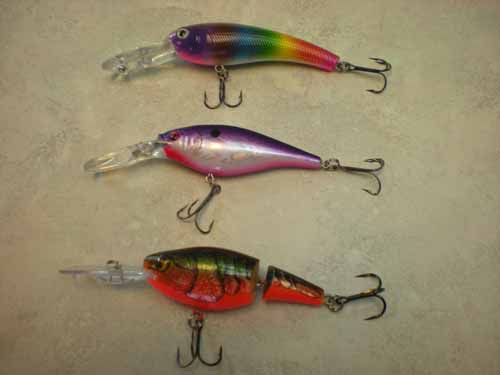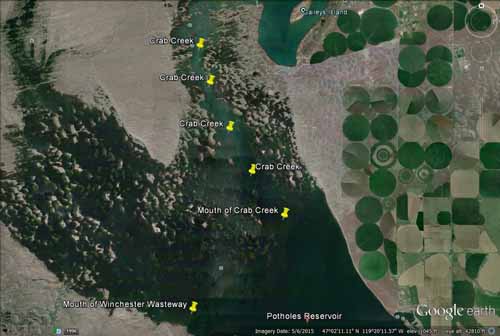Search
Latest Articles
Crankbaits for Walleye
by Keith Jensen, May 31, 2016
As the old saying goes, there’s more than one way to skin a cat. The same is true for catching walleye. In Washington State when someone talks about techniques and tactics for walleye fishing, bottom bouncers and spinner rigs normally dominate the conversations.
Without a doubt, the bottom bouncer/spinner rig accounts for the vast majority of walleye catches in lakes such as Potholes Reservoir, Moses Lake, and Banks Lake. Spinner rigs dominate in Washington State for 2 reasons: 1) They catch walleye. Spinner rigs such as the Mack’s Lure Smile Blade/Slow Death Hook combination account for thousands of Washington walleye fillets to hit the frying pan every year. 2) Spinner rigs are the only technique many walleye anglers use during the fishing season.
Beginning in May and lasting through the summer and fall, however, trolling crankbaits for walleye is a dynamite technique. The benefits of trolling crankbaits for walleye are numerous. The ability to cover a lot of water in a short period of time as well as targeting the most aggressive walleye are two of the biggest benefits.
Covering water with crankbaits first thing in the morning allows a walleye angler to locate concentrations of walleye. A great example of putting this technique to use occurs every summer at the south end of Banks Lake. In July and August, many Banks Lake walleye are chasing balls of perch fry in areas near Coulee City

I will begin my morning on the eastside of the lake inside Goose Island. A large flat extends from the eastern shoreline in this area and extends up lake for a couple of miles. I find where the flat begins to drop to 15-17 feet of water and begin trolling crankbaits. Staying in this 15-17 foot water depth, I will troll the length of this area (roughly 2 miles). Each time we catch a fish on this initial pass I quickly hit a waypoint on my Raymarine Electronics. Walleye are schooling fish, so by marking fish catches with waypoints I am marking areas that are holding walleye. Later in the morning, if the crankbait bite dies, I can then go back to those waypoints and now fish slower with bottom bouncers and spinner rigs.
Walleyes are often called “marble eyes” or “bug eyes” for a reason. They have very large eyes, at least for a fish, and thus are very light sensitive. With these large eyes, walleye do the majority of their hunting in low light conditions. Early morning, cloudy days, wind, rain, and fog create the ideal conditions for walleye to prowl the shallows looking for their next meal. These low light conditions, in turn, are when crankbaits excel for walleye.
Beginning in May, I start every morning trolling crankbaits for walleye. This technique is pretty simplistic with several key points thrown in the mix. Long lining is the name of the game. Long line trolling simply involves trolling your crankbait with no weight at all. I simply tie my mainline directly to the crankbait with no added swivel or weight. I want to allow my crankbait to run and dive freely and dive to the depth it was intended. Speed is critical when trolling crankbaits. Fast is the name of the game with 2.0 to 2.5 mph being the range I focus on. I also prefer to use my kicker motor rather than my electric trolling motor for trolling crankbaits. When traveling at speeds around 2.50 mph for several hours it can take its toll on your batteries. I prefer to save the juice of my batteries if/when I need to switch over to bottom bouncers and spinner rigs.
Windy conditions are crankbait conditions. Wind activates everything in the lake. It pushes plankton to the shores, it pushes bait fish to the shallows, and where the bait fish go so to go the walleye. Fishing the wind can make for a rough ride, however. To help combat these rougher conditions employ a Downhill trolling method. In other words, troll with the wind (downhill). By fishing downhill, your ride is much smoother and your speed is much truer. When fishing uphill into the wind your speed is in a constant flux as your bow crashes into the waves causing your crankbaits to not run at the desired speed.
There are many excellent crankbaits to use when trolling for walleye. Rapala Jointed Shad Rap, Berkley Flicker Shads, and the Bass Pro Shops XPS Laser Crankbaits are 3 crankbaits that Washington State walleye love.

Bass Pro XPS on top, Berkley Flicker Shad in middle, Rapala Jointed Shad Rap on bottom). Crankbaits come in many shapes, sizes and colors. A critical point is to select a crankbait that will dive to the depth in which you are fishing. If I am trolling crankbaits in 15 feet of water, I want a crankbait that will dive down to 15 feet and likewise if I’m trolling in 10 feet of water I select a crankbait that dives 10 feet. Bottom contact while trolling crankbaits is critical. You want your crankbait to periodically hit the bottom and deflect off objects such as rocks. Many times it is this deflection that triggers a walleye strike. Yes, you will get snagged on the bottom at times, but the rewards of more frequent walleye hitting the boat deck are worth the occasional snag.
When choosing what colors to use for crankbaits I prefer to use brighter-shinier colors. Purples, pinks, red crawdad patterns, and brown crawdad patterns are my go to colors.

There is something about purple that walleye love. When looking for walleye crankbaits purple is the first color I seek out.
When selecting a rod for crankbait trolling, look for 7 ½ foot or an 8 foot medium action rod. The Bass Pro Shops Walleye Series 8 foot Trolling Rod was designed specifically for this technique and is ideal for trolling with crankbaits. For reels, I prefer to use a line counter reel such as the Shimano Tekota 3000. I run my crankbaits 120-130 feet back behind the boat so having a line counter reel allows me to precisely place my crankbaits at that distance.
There are many areas in Banks Lake, Potholes Reservoir, and Moses Lake where I troll crankbaits for excellent walleye results. Like any technique, however, there are several key areas that really excel for crankbaits. Earlier I described a key area at the south end of Banks. Beginning in May and lasting through all of June, Moses Lake is a fantastic place to troll shallow running Rapala Jointed Shad Raps and Bass Pro Shops Laser XPS crankbaits. A key area on Moses Lake is an area north of the Blue Heron Boat Launch.

Heading up lake from Blue Heron Park, motor up until you find the first island which will be located on your left (port side). Beginning at the island, troll crankbaits in 8-15 feet all the way up to where the lake makes a large bend. This area holds a lot of rock and structure which in turn holds a lot of feed for the walleye.
On Potholes Reservoir in May and June, target Crab Creek and Winchester Wasteway.

Pick one side of a creek and troll a shallow running Bass Pro Shops XPS crankbait or a Jointed Rapala Shad Rap in size 4 or 5. Troll at 2.0 to 2.5 miles an hour right along the edge of the creek. Then on your way back out, target the other side of the creek. By trolling both sides of the creek you will be able to determine which side is holding the fish and specifically which areas are holding the highest concentrations of walleye.
These are by no means the only places to troll crankbaits for spring and summer time walleye. Many other great areas exist on these 3 bodies of water.
So if you are looking to expand your walleye fishing repertoire, give trolling crankbaits a try. Cover a lot of water, pick crankbaits to target the given depth, and look for those windy, cloudy, low light conditions.
Keith Jensen
Big Wally’s Guide Service




